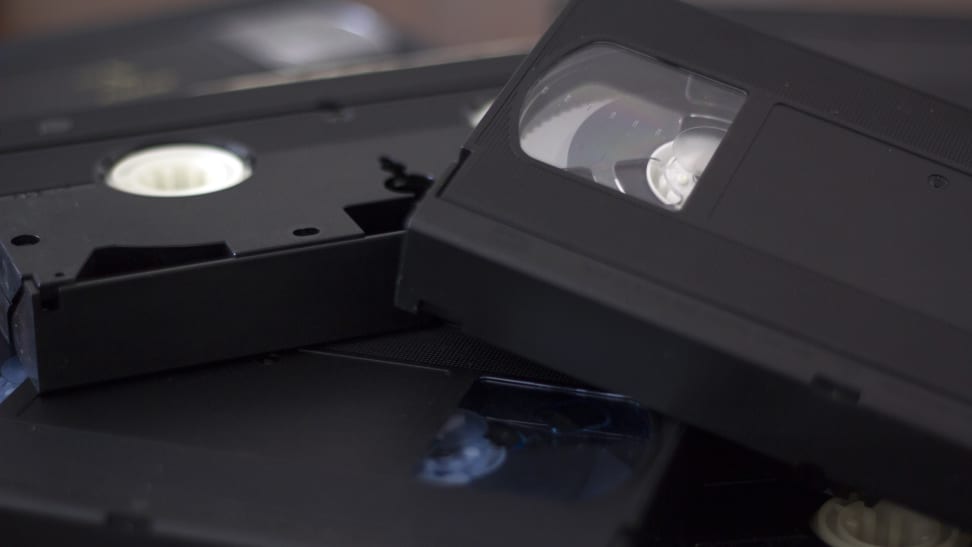5 ways you can still watch old VHS tapes
Because for some of us, casettes still possess a certain magnetism
 Credit:
Getty Images / rfranca
Credit:
Getty Images / rfranca
Recommendations are independently chosen by Reviewed's editors. Purchases made through the links below may earn us and our publishing partners a commission.
Unless you're a total greenhorn in this big, blue-skied pasture we call life, there's a good chance you've watched—and maybe even cherished—VHS cassette tapes in the past.
Maybe you have a collection of Disney classics from your childhood. Maybe you recorded all your home and family films in the format. Maybe you're just video hipsterdom's answer to the vinyl resurgence (I ain't judging).
Whatever your story, your VHS tapes don't need to be relegated to a pawn shop or a dilapidated cardboard box in the attic. There are plenty of ways you can still watch and enjoy them—here's the scoop.
1. Track down a VCR
{{ amazon name="Panasonic PV-V4520 4-Head Hi-Fi VCR", asin="B00004NKHY", align="right" }}
The simplest way to keep watching VHS cassettes meant to be played in a VCR? Buy a VCR!
Unfortunately, this might take some internet- or Goodwill-sleuthing. Breezing through Amazon revealed that new/first-party VCRs and VCR/DVD combos are actually pretty hard to find, though you can find third-party options between around $50 and $100. VCRs are becoming collectible, rare, hard-to-find electronic peripherals—much like the CRTs (tube TVs) they once partnered with.
One good possibility is eBay or Craigslist. While I don't own a VCR, I did manage to track down a very nice, almost-new Sony Trinitron CRT a few months ago at a very reasonable price (except shipping, but what do you expect)? If you've got a collection of VHS tapes you love and you want that original, analog "warmth," watching them on a VCR/CRT combo is the most authentic way to go. Unfortunately, it means you've gotta buy some older electronics and do some hunting and research.
2. Convert your collection to DVD
{{ amazon name="Roxio Easy VHS to DVD 3 Plus Video Converter for PC", asin="B006GOFW3E", align="right" }}
If you don't feel like hunting shelves (virtual or otherwise) for a VCR, I can't say I blame you. Some of the new ones on Amazon are, no joke, like $750. While deep-pockets collectors might snatch up an item like that, for the rest of us, something that can just convert the tapes to DVD is maybe a better choice.
This Roxio VHS-to-DVD converter hardware/software is a little finicky, according to reviews, but overall it works, and is a #1 Best Seller in the Video Editing category. You'll need a Windows PC, but the hardware essentially allows you to "write" the analog contents of a VHS tape onto a DVD.
The caveat? You'll still need something with an AV/composite output, like a TV with a built-in VHS player, or a VCR, that can play the tape. Which kind of brings you back to method #1, but this is a great solution if your tapes are especially old/starting to decay and you're looking to preserve them digitally.
3. Get a TV with a built-in VHS player
{{ amazon name="Toshiba MV13N3 Television 13" TV/VCR Combo Silver", asin="B00F2NE3JY", align="right" }}
This is another kind-of-long-shot, but in the age of the internet, you can find anything if you look hard enough. Amazon might not be a premiere spot to pick up one of those handy old CRTs with a built-in VHS player, unfortunately.
However, I'm willing to bet most people will have some luck tracking one down on eBay, Craigslist, or even sitting on the curb if you're in a more residential area.
I've saved four or five CRTs that weren't being properly disposed of that way. While there's a risk a TV you rescue won't work once you get it home, you'd be surprised how many CRTs left outside still function.
4. Hit up Costco
A little-known fact about everybody's favorite bulk-food membership is that the wholesale retailer also offers a "Home Video Transfer Service." And here we thought we knew all the coolest hidden benefits of a Costco Membership.
With Costco Photo Center's Home Video Transfer Service, $19.99 gets you VHS to DVD transfer (you can also do film reels). This is a great solution if you A) are already a Costco member and have easy access to the service, or B) if you don't want to fiddle with tracking down a VHS player, CRT, or what-have-you.
5. Plug your VCR into your HDTV
{{ amazon name="TCL 49S405 49-Inch 4K Ultra HD Roku Smart LED TV (2017 Model)", asin="B01MYGISTO", align="right" }}
This one might seem obvious, but if you happen to have a VCR or a VCR/DVD combo, you can not only use the combo to transfer VHS tapes to DVDs (with write-able blank DVDs), you can just plug the VCR into the TV.
Most TVs—even the fanciest new 4K/HDR TVs—still have component (the red/green/blue + red/white analog jacks) or composite (also known as AV, the yellow + red/white analog jacks) inputs, allowing to be used as legacy devices. If your TV only has component (RGB/audio), plug the yellow (video) portion of the output cord on your VCR into the green jack of the TV's component input. Plug the audio into the red and white audio inputs, as normal.
The tapes might look a little wonky, but you can always adjust your HDTV's aspect ratio to 4:3 (or "pillarboxed"), which will at least display the VHS tape in the proper square format. You'll probably see some pixels or get some "screen door effect," but all-in-all, you'll be able to watch.
One final caveat for this whole process: it's technically illegal to make copies of VHS tapes that aren't home movies, i.e. recorded yourself. We're not condoning being a video tape pirate, matey, just passing on the methods for preserving your content.

